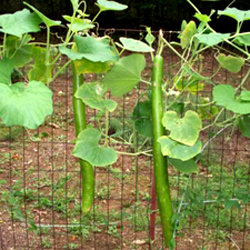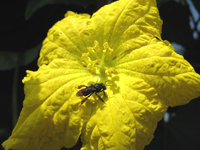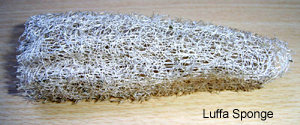





The Longevity of Luffa
Gourds have been utilized by man for more than 10,000 years, making them one of the earliest domesticated plants. [1] Luffa gourds are native to the warmer regions of the world, like southern Asia where they originated, and grown as annuals in the cooler zones. Luffa is a genus of the Cucurbitaceae family, and include many cultivated and wild varieties. Here is a short list with brief descriptions of four popular market luffa gourds:
Luffa has as many spellings and nicknames as it does uses in our past and present cultures for industrial, agricultural, herbal, and home care products (see sidebar below right).
The immature fruit (under 6 inches long) of L. cylindrica and L. acutangula can be pepared and eaten like cucumber, squash, or okra. They can be diced and added to soups, stews, and curries to take on the color and taste of other ingredients. The bossoms and vegetable can be dipped in batter and fried. It is reported to be a good food for diabetics [2], and has antioxidant properties. [3]
The herbal use of various parts of the luffa plant claim cures for everything from rheumatiod arthritis to a diuretic tea. In Asian cultures, herbal luffa is known as Si Gua Luo, and is used in remedies for head, chest, and sinus problems. It is sought after for its sedative, anti-inflammatory, analgestic, and detoxicant properties. [4] [5]
 These fascinating and useful luffa sponge gourds can be grown in zones where their full maturity can be reached in 120 to 180 days.
These fascinating and useful luffa sponge gourds can be grown in zones where their full maturity can be reached in 120 to 180 days.
Location: Luffa initially looks like, and is related to, the cucumber. It prefers well-drained sandy loam, with plenty of organic matter, 6 to 6.8 pH, and prefers high potassium and phosphorous content, but will survive in poorer soils. It is prolific in full sun and will tolerate a little shade.
Planting: The seeds are easily sprouted as soon as the last spring frost has passed. You can extend the growing time by starting the seeds indoors a few weeks before your expected last frost date. Plant seeds 1 inch deep, 4 to 5 seeds per hill, then thin to 2 to 3 seedlings. Space hills 6 to 8 feet apart with tall, sturdy trellis for support of the heavy fruit (dead trees make good supports).
 Growth: The luffa requires a long growing season from 120 to 180 days. It does well in warm climates and is semi-drought tolerant after established, but may need a little moisture during hot spells. Luffa likes mulch to retard weeds and to retain soil moisture. Vine length can be from 15 to 30 feet long. The fruit averages (depending on variety) 24 inches long and up to 3 1/2 inches in diameter. The large leaves are 3 to 5 lobed. The luffa produces up to a dozen large yellow male and female flowers.
Growth: The luffa requires a long growing season from 120 to 180 days. It does well in warm climates and is semi-drought tolerant after established, but may need a little moisture during hot spells. Luffa likes mulch to retard weeds and to retain soil moisture. Vine length can be from 15 to 30 feet long. The fruit averages (depending on variety) 24 inches long and up to 3 1/2 inches in diameter. The large leaves are 3 to 5 lobed. The luffa produces up to a dozen large yellow male and female flowers.
Pests and Diseases: The luffa will suffer from the same insect infestations and diseases as other vegetables in the Cucurbitaceae family (gourds, pumpkins, melons, cucumbers, and squash) for your particular area, so use the same preventive measures.
Harvesting & Saving Seeds: Once harvested, the thin brittle shell is peeled off and the spongey insides are cleaned and dried for later use. Save the seeds from the fruits that best fit your needs, like: straightest, longest, largest diameter, hardiness, thin shell, dense fiber sponge, or other preferences. [6] They will only cross-pollinate within their species (luffa) and after a few growing seasons, you will have a superior gourd from your selection efforts. [7]
 When the vines start to die back, or the gourd stops growing, cut your luffa gourds away from the vine, leaving a few inches of stem. The longer the gourd has to grow, the larger, stronger, and stiffer the sponge pulp becomes when dried. You may have several gourds at various stages of maturity, thus more potential uses for your harvest.
When the vines start to die back, or the gourd stops growing, cut your luffa gourds away from the vine, leaving a few inches of stem. The longer the gourd has to grow, the larger, stronger, and stiffer the sponge pulp becomes when dried. You may have several gourds at various stages of maturity, thus more potential uses for your harvest.
There are several methods used to remove the outer shell from the sponge. You will have to decide which works best for you:
Despite the shell removal method used, be careful to collect the seeds so you can do this again next year!
After the shell has been removed, wash the exposed sponge with a hard spray of water to dislodge the unwanted dusty residue. If the sponge is splotchy, or too dark for your liking, you can whiten it (like the commercial products) with a mild 10% bleach, or hydrogen peroxide, and water solution. The bleaching step is unnecessary, but may be of benefit if you plan to sell your luffa sponges. Place the sponge out to dry in the sun for storage, or start using them immediately.
 If you cut your straightest luffa gourds lengthwise into strips, the dried sponge can be laced together in a parallel manner to create doormats to wipe off muddy garden boots and shoes.
If you cut your straightest luffa gourds lengthwise into strips, the dried sponge can be laced together in a parallel manner to create doormats to wipe off muddy garden boots and shoes.
Luffa can be cut crosswise into slices for souring pads for washing dishes, coated pots, or countertops, without fear of scratching like steel wool pads. The sponges can also be used to exfoliate the skin during bathing, as a back scratcher, or scrubbing dirty hands. The luffa sponges will last a long time if allowed to completely dry out between uses.
Of the many practical uses for the sponge, creating luffa soap is one of my favorites. Sponges sliced into 1/2 inch rounds and positioned into soap molds, can be embedded with melt-and-pour soap, allowed to harden, to form scrubbing soap bars. The dried luffa can, also, be ground into a powder and added to liquid soap for scrubbing hands and facial cleansers.
Author's Note:
I happened onto Dave's Garden in search of luffa sponge gourd seeds for a dear friend (now DGer pdhickey) and me. It was late in the planting season, and we had looked everywhere for a source. Dave's Garden PlantFiles had great information and pictures of the gourd, and generous DGer pieohmy was willing to share seeds with us. You can say, "For the Love of Luffa," we joined DG! Thank you Dave and pieohmy for starting such wonderful traditions in our gardens, homes, and hearts!
Endnotes:
[1] Erickson, Smith, Clark, Sandweiss & Tuross. An Asian origin for a 10,000-year-old domesticated plant... PNAS. 2005.
www.pnas.org/content/102/51/18315.full 4 Dec 2008
[2] Joshi BK, HB KC, RK Tiwari, M Ghale, BR Sthapit & MP Upadhyay. Descriptors for Sponge Gourd. NARC, LIBIRD, IPGRI. 2004.
narc.org.np/publicaton/pdf/book/Descriptors%20Sponge%20gourd.PDF 4 Dec 2008
[3] Du, Xu, Li, Zhao, Jerz, & Winterhalter. Antioxidant Constituents in the Fruits of Luffa cylindrica (L.) Roem.
American Chemical Society: J. Agric. Food Chem. 16 May 2006. pubs.acs.org/doi/abs/10.1021/jf0604790 4 Dec 2008
[4] Dr. Albert L. Leung. Luffa for Health. Leung's Chinese Herb News. 13 Apr 2007
leungschineseherbnews.blogspot.com/2007/04/luffa-for-health.html 4 Dec 2008
[5] Si Gua Luo - Dried Vegetable Sponge. Traditional Chinese Medicine. 2002.
tcm.health-info.org/Herbology.Materia.Medica/sigualuo-properties.htm 5 Dec 2008
[6] ACH-31: Cross Pollination In Cucurbits. Allen Co, Indiana, Horticulture Publications.
www.co.allen.in.us/images/stories/Purdue%20CES/Horticulture/ACH31.pdf 24 Nov 2008
[7] Luffa Info. 2008. www.luffa.info/ 28 Nov 2008
Luffa Nicknames:
Industrial Luffa:
Wiki Commons:
Thumbnail (modified) - Public Domain,
Luffa sponges & bloom - Creative Commons Attribution 2 & 3
Thanks to DGer pdhickey for her photo of Luffa cylindrica growing on the vine.
Copyright © www.100flowers.win Botanic Garden All Rights Reserved